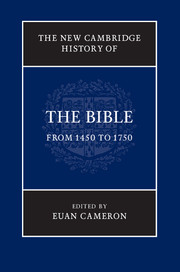Book contents
- Frontmatter
- Contents
- List of figures
- List of contributors
- Preface
- List of abbreviations
- Introduction
- PART I RETRIEVING AND EDITING THE TEXT IN EARLY MODERN EUROPE
- PART II PRODUCING AND DISSEMINATING THE BIBLE IN TRANSLATION
- 7 Publishing in print: Technology and trade
- 8 Latin Bibles in the early modern period
- 9 The Luther Bible
- 10 Bibles in the Dutch and Scandinavian vernaculars to c. 1750
- 11 German Bibles outside the Lutheran movement
- 12 Bibles in French from 1520 to 1750
- 13 English Bibles from c. 1520 to c. 1750
- 14 Bibles in Central and Eastern European vernaculars to c. 1750
- 15 Bibles in Italian and Spanish
- PART III PROCESSING THE BIBLE: COMMENTARY, CATECHESIS, LITURGY
- PART IV THE BIBLE IN THE BROADER CULTURE
- PART V BEYOND EUROPE
- Afterword
- Select bibliography
- Select Bible bibliography
- Index
10 - Bibles in the Dutch and Scandinavian vernaculars to c. 1750
from PART II - PRODUCING AND DISSEMINATING THE BIBLE IN TRANSLATION
Published online by Cambridge University Press: 05 August 2016
- Frontmatter
- Contents
- List of figures
- List of contributors
- Preface
- List of abbreviations
- Introduction
- PART I RETRIEVING AND EDITING THE TEXT IN EARLY MODERN EUROPE
- PART II PRODUCING AND DISSEMINATING THE BIBLE IN TRANSLATION
- 7 Publishing in print: Technology and trade
- 8 Latin Bibles in the early modern period
- 9 The Luther Bible
- 10 Bibles in the Dutch and Scandinavian vernaculars to c. 1750
- 11 German Bibles outside the Lutheran movement
- 12 Bibles in French from 1520 to 1750
- 13 English Bibles from c. 1520 to c. 1750
- 14 Bibles in Central and Eastern European vernaculars to c. 1750
- 15 Bibles in Italian and Spanish
- PART III PROCESSING THE BIBLE: COMMENTARY, CATECHESIS, LITURGY
- PART IV THE BIBLE IN THE BROADER CULTURE
- PART V BEYOND EUROPE
- Afterword
- Select bibliography
- Select Bible bibliography
- Index
Summary
Dutch Bibles
A. A. den Hollander
The first printed editions (1477–1522)
The production of Dutch-language Bibles in the second half of the fifteenth century was largely determined by the book culture of the Low Countries in the late Middle Ages. At that time the handwritten book still held the most important place, and the printed book was only gradually developing into a distinct and independent medium. This development is also evident in the earliest selection of Dutch Bibles that were printed. The texts printed first were the most popular Bible texts: texts for which the demand exceeded the supply. Of the thirty-three Dutch editions of the Bible printed before 1500, the majority (twenty-six) are made up of texts from the Epistles and Gospels, which give the Scripture passages to be used for the readings during the liturgical year. Most of the remaining printed editions are Psalters. In both cases these printed editions are popular works that would have been relatively risk-free for the publisher on account of guaranteed sales in an already existing market. These genres continued to be popular in the first two decades of the sixteenth century, comprising 75 percent of the twenty Dutch Bibles printed in total.
The growing interest in vernacular Bibles is also reflected in the booming production of handwritten Dutch biblical texts in this period, which were not limited only to Psalters and the Epistles and Gospels. The number of hand-written copies produced is naturally significantly lower than the number of printed editions. What is striking is that, during this phase, certain existing types of texts, which used biblical material and had been developed in previous centuries, only finally began to flourish in this period. Thus the genre of the Middle Dutch Life of Jesus, which dates from the last quarter of the thirteenth century, became unprecedentedly popular in the fifteenth century. Furthermore, the fourteenth-century translation of the New Testament by Johan Scutken also grew gradually in popularity, most significantly among lay brothers and sisters from (semi-) religious communities which were influenced by the Devotio Moderna. The vast majority of the manuscripts of this New Testament were produced during the fifteenth century.
- Type
- Chapter
- Information
- The New Cambridge History of the Bible , pp. 239 - 262Publisher: Cambridge University PressPrint publication year: 2016

